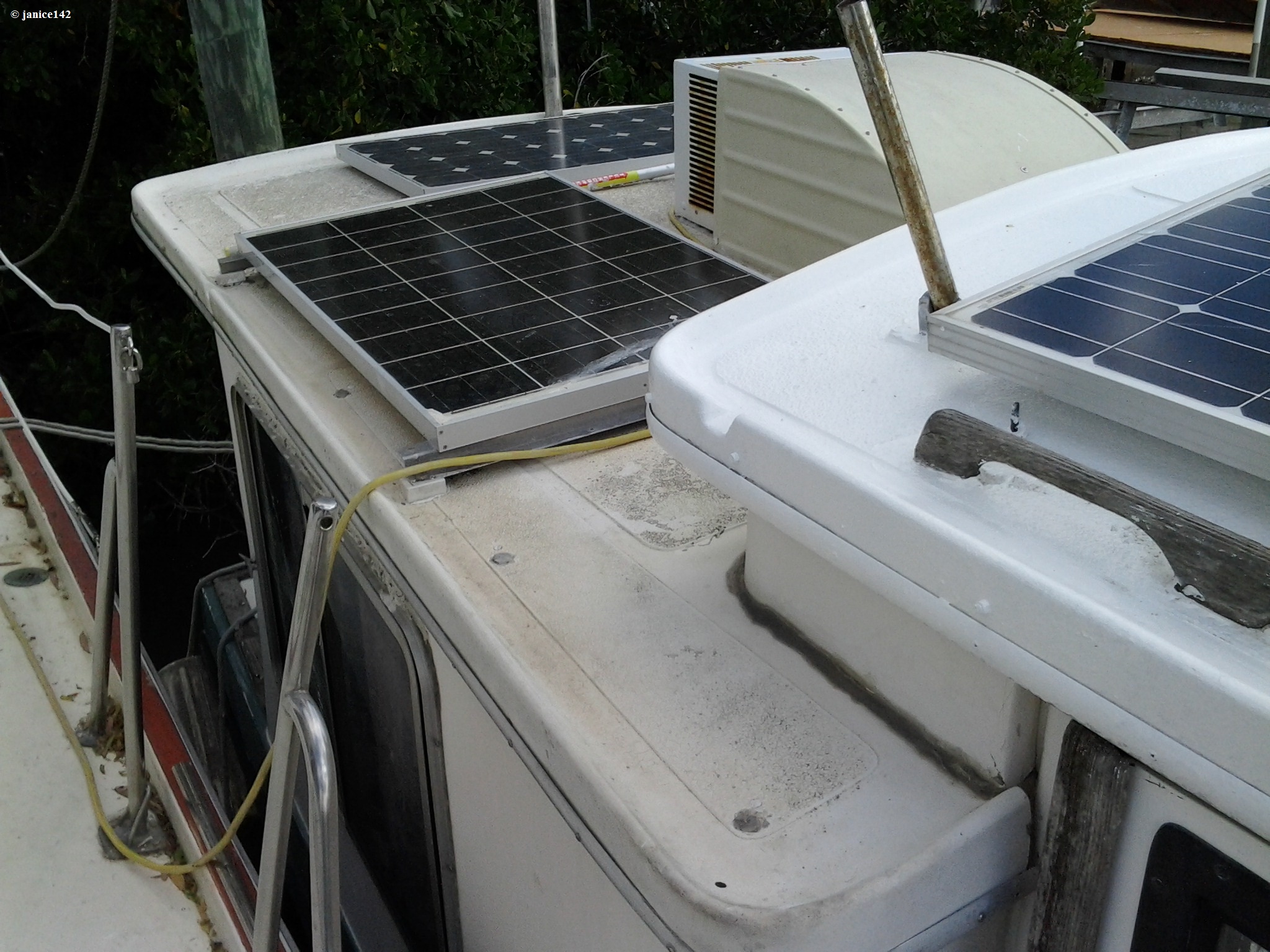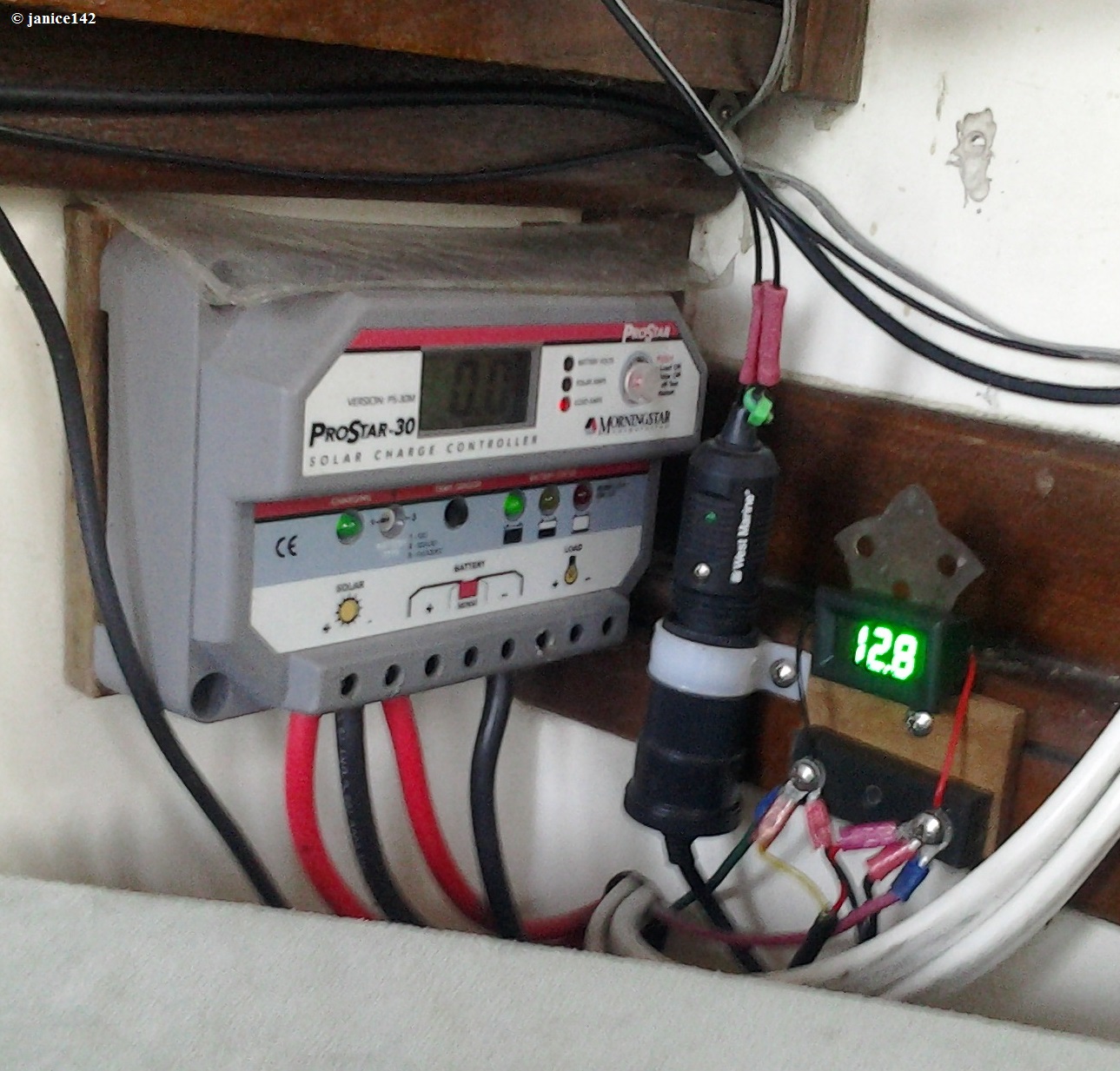![]() Home
|
The Boat |
First Mate
|
Admiral |
Guestbook
Home
|
The Boat |
First Mate
|
Admiral |
Guestbook
Date: 22 October 2021. Solar on Cloudy Days (#5 in series)
© janice142
|
This became a multi-part series on power for an off-grid life afloat. It details the order in which I added power to Seaweed. In the series I cover both the mistakes made, and the choices that were spot on. Feel free to learn from my mistakes.
For those with slower connections I am splitting the series into smaller portions. It is far easier to download a smaller webpage especially when the connection is iffy at best. This is Part Five.
For those that prefer everything
on one page, this is the link you want: |
Of course any off-grid power set-up tends to be tweaked, improved, and upgraded over time. There are always more projects on a boat. We reach one plateau and promptly extend the goalposts a bit further with the next Great Idea. I started with two 100aH batteries, which doubled to four due to the gift from Mary and Christian. Over the years I have increased that to seven batteries in the bilge. That is a lot!
Being able to generate power is only one part of the off-grid solution. Having adequate storage for said power is critical too. Thus, batteries are a required element. And the more, the better.
For a synopsis about
batteries aboard Seaweed,
please read the Batteries
Store Power article.
Chasing green water, I
moved the boat south to the St. Petersburg area.

I've been here meandering around for quite some time. It is
beautiful, albeit crowded.
Once I arrived in St.
Petersburg I was gifted two more solar panels from Bucky. This pair made
a Big
Impact.
Thank you again Cap'n Larry and Eva. Your panels put me over the top
in power production.

The two 85 watt panels were installed outbound above my
galley/dinette area.
The two Bucky panels increased the total wattage of my solar array to 445 watts. That sounds like a lot, and indeed it is. The five panels reliably provide 150aHs per day when it is sunny. This is sufficient for my decadent lifestyle. Excluding the air conditioner, there is zero difference between my life at the dock or while anchored. Those last two panels secured a relaxed off-grid life. I now really don't consider power at all, unless it is cloudy...
|
I currently use approximately 150 amp hours per day. |
|
In total I have seven
batteries, each with the potential to store 100aH. That means
the when batt is fully charged, I have 700 amps. Nigel Calder
in his
Boatowners Mechanical and Electrical Manual 4the Edition tome recommends that
folks like me with Lead Acid batteries not take our batts down
below 50% of full. Thus, though I have 700 amps of power
it is unwise to use more than 350aH of said total.
|
I am happiest when my
batteries are above 12.4 though that is not
usually possible until the sun shines on my solar panels in
the morning.

| Cloudy Days | Battery Bank Amps | Daily Use normally 150aH |
*Charging Via Solar | Percentage Available |
| Starting Amps | 700aH Batts Full |
Normally on a sunny day the batteries recharge to full via solar panels. *Charging Via Solar ... even on a cloudy day I can generally get in 30 amps via my 445 watts of solar panels. |
||
| Day 1, start | 700aH | minus 150 = 550aH | plus 30 = 580aH | 83% |
| Day 2, start | 580aH | minus 150 = 430aH | plus 30 = 460aH | 66% |
|
Due
to batteries going down I would now cut back to 100aH daily... |
||||
| Day 3, start | 460aH | minus 100 = 360aH | plus 30 = 390aH | 55% |
|
At this point, Day 4, the refrigerator has
to be shut down. I am in a difficult situation.
|
||||
I primarily rely on solar to
power my life off-grid.
With the reefer turned off, I can maintain a minimal lifestyle at anchor. Although I won't be nuking popcorn I can utilize propane for cooking. I will still be able to visit Trawler Forum online via the lovely tablet I was given. Thank you again Cap'n Gary for that. I never imagined how cool a tablet could be! And too, my Kindle beckons on these lazy days of autumn... I indeed blessed.
The thing is, as long as I am having windy days I can manage to continue life as normal with the power generated by my Air-Breeze wind generator. It will supplement the lack of solar on cloudy days. Often times, if the sun is not shining there is some wind.
I will say that in Gulfport I found the breezes
I had missed since the east coast.

This Tidewater center console boat is heading
across the bay near Gulfport.
The Problem with Gulfport is that my boat is smaller than most. Gulfport has a great deal of fetch. I explained fetch in the By the Shipyard article. Basically the danger occurs if there is a long distance between you and the shoreline combined with winds. Winds will cause the waves to increase.
For those of us with smaller vessels, it is wise to anchor in areas with nearby shorelines. This means I chose to be out of those winds, thus must rely on my solar system for power. Solar when combined with a hefty battery bank enables my life to be incredibly decadent. But there's more to it than that. The next article will conclude the series.
Thank you for reading. Happy boating.
I am curious as to how large a solar array you have? Or plan to have...
And, how much battery capacity do you have?
|
Regarding the Comments Section, found at the end of every article:
|
COMMENTS:
© 2021, © 2023
Categories: Boat Talk, Boats, Books, Characters, Gear, Locations,
Adding Renogy and Upgrading Solar Regulator (#4 in series) ~
Previous Post ... ![]()
... Next Post
~
And in Conclusion (#6 in series)
The Archive holds a running list with synopsis of published articles, and links to same.
A favorite aphorism: Wind's in the east, mist coming in. Like somethin' is brewin' and about to begin. Can't put my finger on what lies in store, but I fear what's to happen all happened before. P.L. Travers in Saving Mr. Banks aka Mary Poppins.
Every gift helps.
The Cruising Kitty is what boaters refer to as spending money. There's never enough aboard Seaweed!
I am also an Amazon Affiliate.



